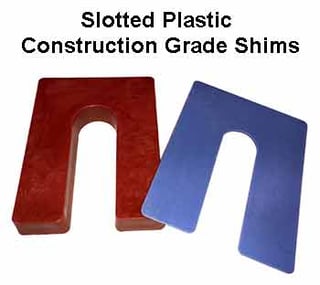The typical Slide Bearing design used in Steel Fabricating, whether Teflon®, Virgin PTFE or Fluorogold®, is 7/32” thick. This is comprised of a 1/8” thick steel backing plate and 3/32” Teflon® bonded to it. Most often, they are in pairs with the Teflon® surfaces in the middle as shown in the illustration.

As configured above the Upper and Lower Slide Bearing Assembly would be 7/16” thick.
At times we see drawings calling for thicker slide bearing assemblies. The designer often accomplishes this by increasing; 1- The thickness of the backing plate, 2- The thickness of the Teflon® or Fluorogold®, or 3- they increase both.
This is an acceptable approach, and it will get the job done, but often it incurs unnecessary cost and expensive project delays. As well, increasing the thickness of the Teflon® will also increase the amount it compresses under a load. When the load is great enough the compression becomes permanent and the desired thickness is lost. A simple understanding of that principle can be found in the compression tests The Steel Supply Company performs on our construction grade plastic shims.
Using as an example, the Slotted Plastic Shims 3” x 4” below show the compressive strengths, as derived from the most recent set of tests. It is important to understand the criteria for success and failure of the product being tested. In the case of Plastic Construction Shims, that is “Permanent Deflection.” In other words, the shim is compressed under a load, the load is released, and the shim is examined to see if it is still its original shape and dimensions. Then the load is increased, the shim is checked again for dimensions. This process repeats until “permanent deflection” occurs, meaning after the load is removed, the shim does not return to its original dimensions. This is an essential characteristic, in which both of our Slotted Plastic Shims and Solid Plastic Shim Plates are intended for use in Steel Fabricating and Erecting, Concrete and Masonry Contracting, Plate Glass, Tilt-Up Concrete, Curtain Wall and many other very demanding areas of construction.
3” x 4” Slotted Plastic Shim 
Shown in photo
Thickness Compression
1/32” 127,000 lbs.
1/16” 95,000 lbs.
1/8” 75,000 lbs.
1/4” 70,000 lbs.
3/8” 45,000 lbs.
1/2” 30,000 lbs.
As the chart illustrates, these shims made from the same High Impact Polystyrene or Polypropylene Plastic have an ability to resist compression that decreases as the shim gets thicker. The same holds true for Teflon®, PTFE or Fluorogold®. So with that in mind, when designing a Slide Bearing, taking up space by increasing the thickness of the Teflon® comes with additional factors.
The more common way a designer will make the Slide Bearing taller is to increase the thickness of the backing plate. While this is a more secure solution, it still creates cost and project delays, in that it is a made to order product. The simplest and fastest way to increase the thickness of the assembly is to add an additional shim backing plate.
Starting with the standard FC-1010-CS Slide Bearing Assembly, which is 7/16” thick counting the upper and lower member, add a solid steel shim plate to either the top or bottom at the thickness required. The shim plate should be at least the same dimensions as the backing plate it is in contact with. It can be longer or wider if the circumstances call for it. Any holes or slots in the slide bearing should be exactly the same in the shim plate. Also, it is essential that the holes and slot are aligned perfectly with the ones assembled. It’s usually best to do this before the Slide Bearing is installed and tack weld the spacer shim and backing plate, rather than trying to align everything during erection.
It is always recommended that any change in design be approved by the project engineer.
To learn more about Slide Bearings, click the button below.





